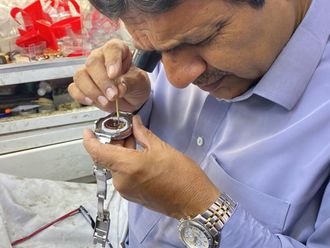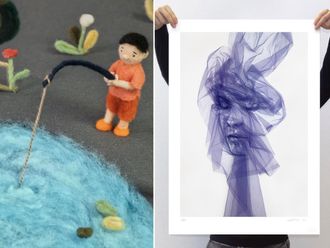
Welcome to the new workplace trend in town: Mouse-shuffling and trust us, it’s not as cute as it sounds. This trend is the newest entry in a post-pandemic lexicon of workplace trends that includes 'quiet quitting', 'coffee-badging', 'quiet vacationing', and 'shadow policies'.
So, what is it? Well, you can forget the free-spiritedness of the adage ‘dance like nobody’s watching', employees now feel compelled to work like everyone’s watching. They adopt a hyper-focused ethic as if under constant surveillance. In other words, with the new mouse-shuffling trend, people pretend to be productive, by constantly moving their mouse, being seen, or appearing online.
‘The pressure to be visibly active’

So, what’s the harm in mouse-shuffling? Well, a lot.
Rommel Sergio, Associate Dean and Professor of Management at the Canadian University Dubai, breaks it down. “It is harmful, as it promotes a culture of superficial productivity, rather than actual productivity. People feel pressured to maintain a constant online presence, leading them to focus more on appearing busy than completing meaningful tasks,” he says. This behaviour undermines the quality of work and affects the overall well-being of the employee. “It shifts the emphasis from delivering results to simply being present, eroding trust between the employees and management, as well as diminish job satisfaction and morale.”

It is harmful, as it promotes a culture of superficial productivity, rather than actual productivity. People feel pressured to maintain a constant online presence, leading them to focus more on appearing busy than completing meaningful tasks...
This trend is particularly stressful, as it generates a constant pressure to be seen as visibly active. People feel worried that they are perceived as unproductive or disengaged, if they are not continuously just shuffling the mouse around, pretending to be busy, he adds. The stress is exacerbated by the challenge of balancing genuine work tasks, with the need to maintain a presence, online or otherwise.
As Sergio explains, the fear of being judged for not being busy or not appearing busy fuels the anxiety and a sense of insecurity. Moreover, maintaining this illusion of productivity also generates a sense of guilt while hindering productivity. Rather than concentrating on substantial tasks, employees become trapped in this farcical cycle, often engaging in inconsequential activities such as idle chat or Slack messages.
Spot the signs of mouse-shuffling

It’s not just actually shuffling the mouse; this false sense of trying to look busy has several iterations.
Advait Chauhan, a Dubai-based senior marketing manager explains from first-hand experience. He recalls coming across an employee frantically typing gibberish on a document whenp the boss walked by. Another colleague would determinedly keep switching between several tabs open to harbour the illusion of multi-tasking.Another ruse would be poring over social media diligently, pretending to gather information, when they are disinterested and bored, as Chauhan recalls.
Disengaged, yet pretending to be engaged at work

Such patterns signal a disengaged workforce, says Rowen Astrom, a Dubai-based corporate communications specialist, and a business coach. "It is the post-Covid era’s response to clocking in and out of work, where employees might feign productivity by appearing present or online," she says. "However as we know, presence whether remote or in-person, doesn’t always mean productive."
And this disengagement from the workplace is becoming increasingly common today, as psychologists explain. Essentially, mouse-shuffling could be considered a behavioural symptom of a ‘cognitive disengagement’ syndrome, explain psychologists. It's a way for people to cope with the pressure to be constantly productive while mentally disengaging from their actual work.
Diya Mallick Ganguly, a Dubai-based psychologist explains the patterns of the cognitive disengagement syndrome, which include constant sense of demotivation, tiredness, and lack of energy.

Presence, whether remote or in-person, doesn’t always mean productive, and such behaviours could signal a disengaged workforce....
Maria Harris, a Abu Dhabi-based psychologist links this to mouse-shuffling by saying, “At the core of both cognitive disengagement and mouse-shuffling, lies a psychological tension between the ideal self and the actual self. The ideal self is the image we project to others - in this case, the image of a constantly engaged and productive employee. The actual self, however, might be experiencing boredom, fatigue, or a lack of motivation."
Cognitive disengagement as a defence mechanism allows the person to psychologically distance themselves from the demands of the task. It's a way to protect self-esteem and avoid feelings of inadequacy, she says. Mouse-shuffling is a behavioural manifestation of this disengagement. It's a visible attempt to align the external appearance with the desired self-image, even when the internal experience is quite different.
There could be several reasons behind these behavioural patterns. For starters, a performance-oriented culture can intensify the pressure to appear constantly busy, explains Harris. To cope with this pressure, they disengage from work. However, anxiety creeps in: What if they’re fired? So, they try to look productive. Harris adds, “The perception of being busy, even if superficial, can reinforce the belief that one is meeting expectations, perpetuating the cycle.”
How does one break free from the mouse-shuffling?
As Sergio explains, mouse-shuffling is harmful on an individual and a collective level. “On a collective level, this behaviour can create a toxic work environment, where employees are judged based on appearing to be busy, rather than their actual contributions. It leads to inefficiencies and miscommunications within teams, as the focus shifts away from collaboration and effective work practices. This misalignment can hamper the organisation's overall productivity and hinder its ability to achieve strategic goals,” he says.
So, what is the solution?
Companies should trust employees to manage their time effectively and achieve goals, rather than obsessing over online presence, explain the psychologists. This highlights the need for a cultural overhaul that prioritises output and results over mere visibility. Building trust and measuring performance based on achievements is essential to combat this trend and foster a healthy, productive workforce.
Ganguly explains, “There should be a creation of a workplace culture, that supports open communication, where employees feel comfortable discussing their struggles and seeking help is a crucial first step.” She adds that traditional performance reviews aren’t entirely the most reliable, managers should do weekly check-ins, or create brief weekly meetings between employees and supervisors, to take stock of things. “Organising days to check in, where managers ask two simple questions: ‘What do you need to get through your tasks?’ and ‘How can I help?’ can make a significant difference,” she explains.

There should be a creation of a workplace culture, that supports open communication, where employees feel comfortable discussing their struggles and seeking help is a crucial first step....
Simple conversations like these empower employees, instil confidence that they will be supported in getting the work done, and shift their focus from merely completing tasks to fostering innovation, she adds. “More importantly, these talks give employees a sense of purpose and allow them to contribute meaningfully,” she says.
The experts suggest the following tips:

Fostering a culture of trust and flexibility is crucial. Employers should promote a supportive work environment where employees feel valued for their contributions. Ganguly adds, "Organisations should establish 'wellbeing pockets' or 'innovation hours' where employees are encouraged to think creatively about their work.
Enhance communication and set clear expectations. This can address the root causes of 'mouse-shuffling'. Regular check-ins and clear guidelines for availability and responsiveness can help ensure that employees understand their tasks and feel supported.
Employers should offer resources and support for mental health, encourage regular breaks, and advocate for a healthy work-life balance. By focusing on these strategies, employers can create a more productive, healthy, and supportive work environment that values genuine contributions over superficial online presence.
Contingent-reward system to recognise their employee’s contributions. In simple terms, this means rewarding employees based on the completion of specific tasks. However, it's time for employers to shift focus from what tasks are completed to how they can be done differently.











